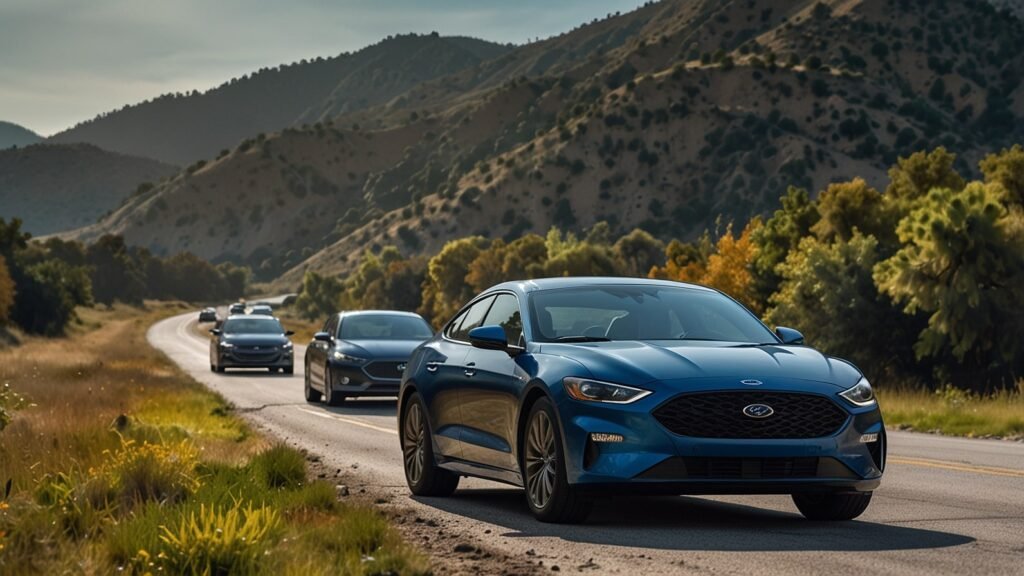
The automakers are on a rocky road after new tariffs on imported auto parts were imposed, and they vary between 10 per cent and 25 per cent. These tariffs, which are directed at such essential elements as batteries, semiconductors and steel, are increasing production expenses in the entire $1.2 trillion U.S auto sector. As supply chains are stretched and consumer wallets are stretched, carmakers are reconsidering the pricing approach to strike the right balance between profitability, competitiveness, and affordability.
Whether it is absorbing cost and transferring it to buyers, adding value to trims, and doubling efforts on production domestically, these changes are altering the way vehicles, including electric SUVs and gas-powered pickups, find their way to the market. This article discusses what drives these changes, how it affects their prices, and the implications of the same to the consumer and the future of the industry.
The Tariff Trigger: An Exorbitantly New Reality
The tariffs, which are expected to be introduced in early 2025, are expected to support domestic manufacturing by imposing a tax on imported components, especially components imported by China, Mexico, and Canada, which provide more than 60 percent of the annual auto components used in the U.S.
An example is a 20 per cent tariff on Chinese lithium-ion batteries, or a 15 per cent tax on Mexican wiring harnesses, which have the direct effect of making cars produced in the U.S. significantly more expensive. One Ford F-150 that uses cross-border parts will have an increase in production cost of $1000 to $2000, according to the industry estimates. This is in addition to pre-existing strains, including semiconductor shortages, escalating labour costs, and the shift to electric vehicles (EVs), which require more expensive parts such as battery packs.
The automakers have a difficult decision to make: either take these expenses and run the risk of razor-thin margins, or push the expense onto the consumer, which might stifle new vehicle purchases, already averaging $48,000. The challenge is increased by the complexity of global supply chains, in which a single car part can pass through multiple countries a number of times. As U.S. consumers focus on the affordability issue (due to 2.5% inflation and 6% loan rates), automakers are implementing innovative pricing strategies to remain competitive in the face of the storm caused by the tariffs.
Loss-Leading Costs to Secure the Market Share
Large players such as General Motors (GM) and Toyota are selectively bearing the cost of tariffs to retain market shares in areas with high volumes, such as SUVs and trucks. An example of this is GM, which has promised that it will keep increases in prices of its Chevrolet Silverado to 1 per cent, even though the price of the trucks has gone up by $1,500 each, as a result of tariffs on Canadian transmissions and Mexican steel.
The plan that is based on reducing marketing expenses and optimising operations is meant to ensure that Silverado can remain competitive with its competitors, such as Ram 1500. Toyota, in its turn, is consuming $800 a RAV4 by sourcing the costly U.S.-manufactured alternators, maintaining its initial price of $31,000 to target low-income families.
Smaller companies, such as Rivian, have more difficult decisions. It is an EV start-up that is heavily dependent on imported batteries and has taken up 10 per cent of the tariff on its R2 SUV, introduced at 45000 dollars, to compete with its rivals like the Tesla Model Y. But this narrows margins, and Rivian must reduce expansion plans. These attempts are indicative of a larger pattern: cost absorption is a temporary tactic to keep customers, but cannot be sustained without permanent solutions to the supply chain.
Transference to the Consumers: Strategic Price Increases
Not every automaker is able to absorb tariff prices, and this results in the selective pricing, such as raising the prices of premium or low-volume vehicles. Stellantis has increased the price of its Jeep Grand Cherokee by 3 percent, or 1 200 dollars based on tariff on Asian electronics and European aluminum.
The relocation will focus on high-income consumers who are not as price-sensitive, as it will maintain profitability on higher-margin lines such as the Summit Reserve. On the same note, the ID.4 EV by Volkswagen, which is based on Chinese batteries, had a price increase of 1,500 USD to 41,500 USD, but the company countered this by offering free charging credits to reduce the impact.
To reduce the backlash, the automobile manufacturers are justifying increases as value additions. The 2025 Mustang Mach-E has a new 15.5-inch touchscreen and Level 2+ driver aids, adding $1,000 to its price, making it more of an upgrade of the technology than a tariff tax.
This approach is being echoed in the urban markets such as California, where consumers value features more than base price. Nevertheless, price-sensitive markets such as the Midwest still face the threat of having to lose even small increases in pricing, thereby forcing customers to switch to used vehicles, where the pricing has already dropped by 8 per cent to 26,500.
Trims and Incentives of Good Values
In a strategy to cope with the cost pressures and consumer demand, automakers are unveiling the mid-tier trims that are full of features to justify the prices. Hyundai has added wireless CarPlay and a heated steering wheel to the 2025 IONIQ 5 SE Standard Range, costing $42,000 (an increase of $500) to the perceived value.
At $30500, the Corolla Cross Hybrid by Toyota includes all-wheel drive and adaptive cruise as standard features, which swallows the blow of a tariff of $700 and attracts young families. These trims are positioned between the entry-level and luxury, which consumers can afford to spend.
Another weapon is the use of incentives. GM has also been providing 0.9 per cent APR financing on select Buick Envision models, even at the increased price of a thousand dollars, to ensure that the monthly payments are less than half a thousand dollars.
Kia also has the Drive Green program that offers a cashback of $1,500 for the EV6 to cover the upfront costs associated with the tariffs and comply with federal EV credits, which remain applicable to U.S.-assembled models. And auto dealerships are also offering incentives of no-charge maintenance or long warranty, especially on CPO vehicles, to entice sceptical customers in a high-rate environment.
The Two-fold Strategy of Domestic Production
In the long term, car manufacturers are moving to in-country sourcing to avoid tariffs, but the process is expensive and time-consuming. Ford has invested 2 billion US dollars in a battery factory in Tennessee, which should generate 40 GWh of electric vehicles each year by 2027, and which should localise EV parts used in such models as the F-150 Lightning.
The collaboration between GM and LG Energy on Ohio-produced batteries protects its Equinox EV against the increase in tariffs and keeps the prices unchanged at 33,600. Such actions are in line with the domestic content policies of the USMCA, which would make it eligible to receive $7,500 EV tax credits- a key selling point as credits completely go dead by 2026.
Smaller players have obstacles. Stellantis, which depends on Mexican components to produce its Dodge brand, is considering a new plant in Texas, worth $500 million, which will not produce until 2028. Up to that time, brands such as Chrysler could be supported by an increase in prices or low production.
Other small firms, such as Lucid, are collaborating with U.S. manufacturers of motors because it has limited capital, leading to reduced tariff risk, but increased expenditure by 5%. Such changes are pointing to a larger industry shift towards localised supply chains, driven by tariffs, but limited by infrastructure and labour needs.
Consumer and Market Forces
To the consumers, these tactics represent both good and bad. The premium buyers were not largely affected by the price increases on models such as the Jeep Grand Cherokee; however, the entry-level shoppers are forced to make more difficult decisions.
On a 30,000 Kia Seltos, a rise of 1,000 will increase monthly payments to $580 instead of $550, a strenuous burden in states such as Georgia or Arizona. On the other hand, there are value cuts and mechanisms that come up with offers–customers who buy the Hyundai Tucson with an incentive of 2000 cashback claim savings that are tariff-free.
Dealers are adapting, too. The online sales and flexible financing allow urban lots in New York and California to move inventory, whereas rural dealers are finding it challenging to move inventory with high floorplan costs. Budget shoppers are being drained by the used car market, which is dropping to $26,500, and auto makers have to fight each other over new car deals. EVs, regardless of tariff pressures, have federal credits, and such models as the Tesla Model Y could remain competitive at a post-incentive price of $47,990.
The Road Ahead: A Dancing Act
The pricing policies of automakers within the tariffs of 2025 are a fine line to walk: they must be affordable, but ensure the profitability of their activities in a very expensive environment. Hosing out costs retains a customer base at the expense of the pocket, whereas price increases run the risk of losing demand.
Cutting value and incentives walk a fine line but require a certain size. The promise of domestic production will not completely compensate for tariffs in the years to come, as carmakers will be left in situations where short-term strategies are all that can be applied.
To customers, the solution is simple: plan on shopping. Cross-sell, aim at the middle-of-the-pack trims and build low-rate financing where applicable. The agility of automakers will dictate the winners as the costs change due to tariffs. As EV sales will reach 25 per cent by 2027 and gas cars remain a force to be reckoned with, the pricing moves of 2025 will be an innovation trial, where the industry will be under pressure to provide value in a tariff-ridden world.

